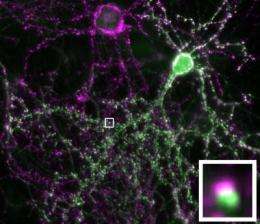Communication problems in the brainMaturation disorders of nerve terminals may trigger autism

For brain cells to communicate, the contacts to each other must function. The protein molecule neuroligin-1 plays an important role in this as it stimulates the necessary maturation processes at the contact sites (synapses) of the nerves. A synaptic maturation disorder is possibly involved in the development of autism.
Dr. Thomas Dresbach and his team from the Institute for Anatomy and Cell Biology at the University of Heidelberg, Germany, in cooperation with the study group led by Professor Dr. Thomas Kuner at the same institute and Professor Dr. Nils Brose, Max Planck Institute for Experimental Medicine in Göttingen, have published their results in the prestigious international journal PNAS (Proceedings of the National Academy of Sciences).
One hundred billion nerve cells make our brain a thinking machine. Each of these nerve fibers produces a long extension, the axon, which terminates in numerous small knobs. Transmitters are released here that transfer information to the next nerve cell. The contact site between nerve ending and adjacent nerve cell is called a synapse. The number and location of active synapses determine which areas of the brain are especially active at a given time.
Neuroligin-1 protein necessary for maturation
The synapses of young nerve cells must mature before they can release their neurotransmitters to the full extent. Researchers were able to show using genetically modified nerve cells from mice that the postsynaptic nerve cell, the receptor, must form a sufficient amount of a certain protein molecule, neuroligin-1, to allow this maturation process to take place. In addition, the nerve endings from where information is sent must release slight amounts of neurotransmitters to stimulate the neuroligin in the postsynaptic nerve cell.
"A fully functioning contact can develop only if both sides, transmitter and receptor of information, are involved in the maturation process," explained Dr. Dresbach. If no neuroligin-1 is formed, the nerve endings remain at an immature stage and release fewer neurotransmitters; the flow of information is interrupted. The nerve endings can only whisper, so to speak.
Autism caused by a malfunction at the synapses?
"The results are significant for actual concepts about how autism develops," says Professor Dr. Joachim Kirsch, director of the Institute for Anatomy and Cell Biology. Symptoms of autism are first noticed in early childhood as an information processing disorder. The symptoms may be more or less pronounced, but all patients display weaknesses in social contacts and communication. "There are many indications that malfunctions of synaptic molecules are involved in the development of this illness. It has thus far been unclear exactly what these malfunctions are, but we now know what to look for," says Professor Kirsch.
More information: Postsynaptic Neuroligin1 regulates presynaptic maturation. Wittenmayer N, Körber C, Liu H, Kremer T, Varoqueaux F, Chapman ER, Brose N, Kuner T, Dresbach T. Proceedings of the National Academy of Sciences USA, 2009, 106(32): 13564-13569. Epub 2009 Jul 23.














